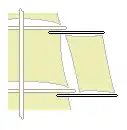Studding sail
A studding sail, studsail, or stunsail[1] (traditionally pronounced stuns'l /ˈstʌnsəl/) is an extra sail on a square rigged vessel or 1950s racing skiffs for use in light winds.
.jpg.webp)

Description

A studding sail is an extra sail hoisted alongside a square-rigged sail on an extension of its yardarm. It is named by appending the word studding to the name of the working sail alongside which it is set, for example, "fore topsail studdingsail".[2] These sails provide extra speed in fine weather.[3]
Studding sails have also been used to increase the sail area of a fore-and-aft spanker, again by extending the upper spar. Such a sail extending the leech of a fore-and-aft sail is known as a ringtail.[4] Ringtail sails were used by flying 18 foot skiffs in Sydney Harbour in the 1950s to enlarge the downwind sailing capacity in light airs. Sails that extend below the boom to deck level or lower are known as watersails.
References
- Lubbock, Basil (1921). The Colonial Clippers. Nautical Press, Glasgow, J. Brown & Son (Glasgow) Ltd. p. 198.
- King, Dean (2000). A Sea of Words (3 ed.). Henry Holt. p. 424. ISBN 978-0-8050-6615-9.
- Keegan, John (1989). The Price of Admiralty. New York: Viking. p. 281. ISBN 0-670-81416-4.
- Kipping, Robert (1904). Sails & Sailmaking. Lockwood. pp. 163–164. Retrieved June 16, 2020.
Bibliography
- Harland, John (1984). Seamanship in the age of sail. Conway Maritime Press. ISBN 0-85177-179-3.
| Wikimedia Commons has media related to Studding sails. |